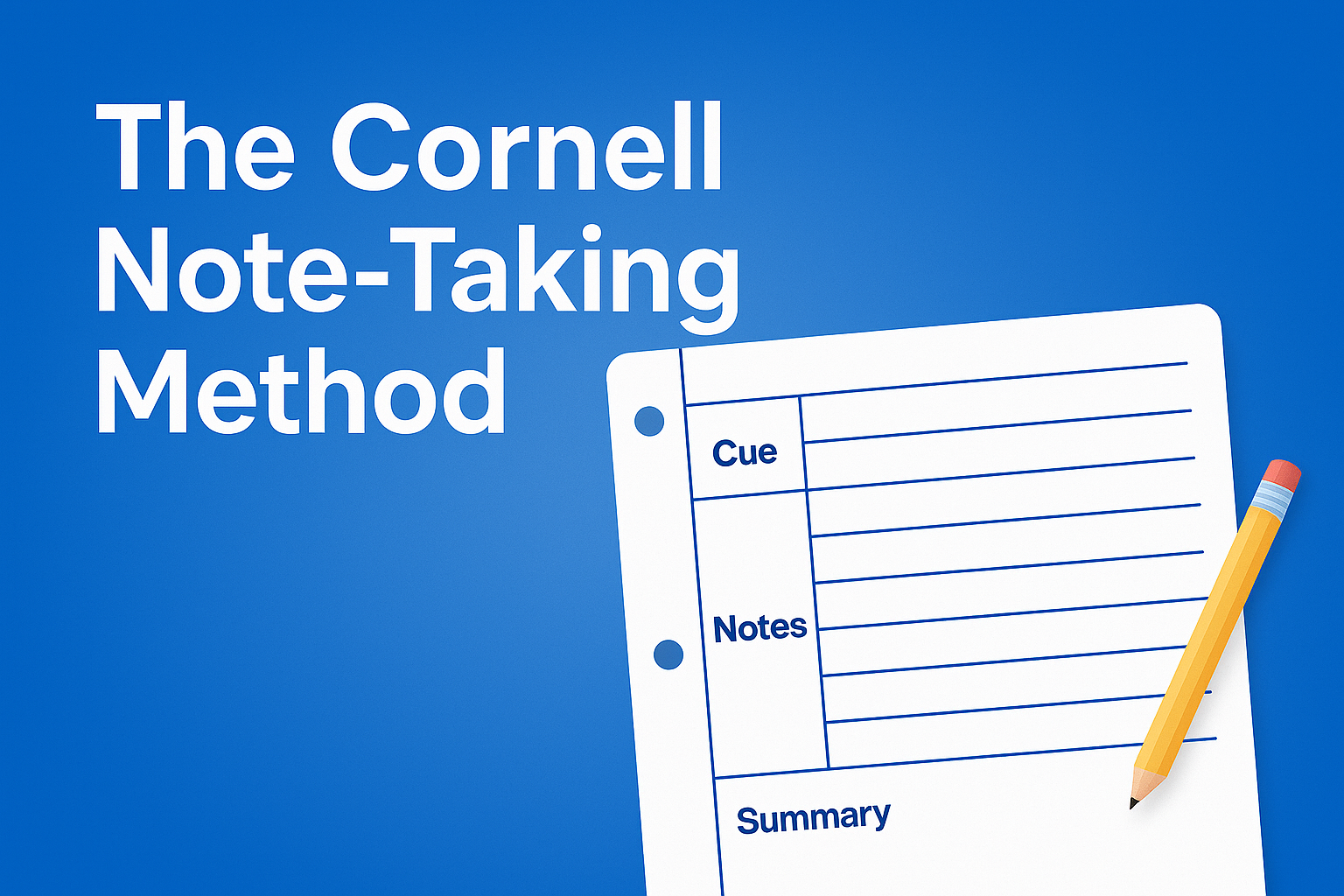The Cornell Note-Taking Method: A Smarter Way to Capture and Retain Information

Admin
Author

The way you capture information says a lot about how your mind works.
Visual learners might map out ideas using charts, diagrams, and sketches, while analytical thinkers often prefer orderly outlines and systematic lists to break complex topics into clear steps.
No matter your personal learning style, developing strong note-taking habits is key to truly understanding and remembering what you study.
One highly effective method is the Cornell Note-Taking System, a simple but powerful framework that organizes your notes into key points, detailed content, and a concise summary.
In this blog, we’ll explore how to structure your notes using the Cornell format and share practical tips to maximize its benefits for your learning and productivity.
What Is the Cornell Note-Taking Method?
The Cornell Note-Taking Method is a structured system designed to help students and professionals take better notes, retain information, and efficiently review material. Created by Professor Walter Pauk at Cornell University, this method divides a page into three sections:
Cue Column (Left Side): Write keywords, questions, or prompts.
Notes Column (Right Side): Capture detailed notes during a lecture, meeting, or research session.
Summary Section (Bottom): Write a brief summary of the key takeaways.
This approach simplifies studying and makes reviewing notes more effective. This structured approach transforms passive note-taking into an active learning process that enhances comprehension and long-term memory retention.
Why Use the Cornell Method?
1. Improves Organization
Traditional notes can become cluttered and hard to review. With the Cornell Method, your notes are structured in a way that makes it easy to scan, search, and recall key details.
2. Enhances Retention
By summarizing and asking questions, you engage in active learning. This helps reinforce concepts and improves long-term memory.
3. Speeds Up Studying & Reviewing
Instead of re-reading long notes, you can focus on the cue column and quickly recall key details.
4. Works for Any Subject or Industry
Whether you're a student, business professional, or researcher, this method helps you retain information from classes, meetings, books, and presentations.
How to Use the Cornell Note-Taking Method (Step by Step)
Step 1: Set Up Your Page
Divide your page into three sections:
Left: Cue Column (30%)
Right: Notes Column (70%)
Bottom: Summary (about 20% of the page height)
Step 2: Take Notes in the Right Column
Use bullet points, diagrams, and abbreviations for quick note-taking.
Avoid writing full sentences—focus on key points and concepts.
Step 3: Add Cues in the Left Column
After the lecture or meeting, fill in keywords, key concepts, or questions.
These cues help trigger your memory when reviewing.
Step 4: Summarize Key Takeaways
Write a short, concise summary at the bottom of the page.
Highlight the most important points in 2-3 sentences.
Step 5: Review and Revise Regularly
Cover the notes section and use the cues to test yourself.
Regularly reviewing notes ensures better retention over time.
How AI-Powered Tools Like Karax Improve the Cornell Method
Taking notes manually can be time-consuming. That’s where AI-powered meeting tools like Karax can help.
Key Benefits of AI Notetakers:
✔ Automated Transcription: Capture every word from lectures, meetings, and presentations.
✔ Smart Summarization: AI generates key takeaways for the summary section.
✔ Keyword Extraction: Identify and highlight critical concepts for the cue column.
✔ Searchable & Shareable Notes: Digital notes are easy to find, organize, and collaborate on.
✔ Integration with Productivity Apps: Sync notes with tools like Google Drive, Notion, and Slack.
By using Karax, you can combine the structure of the Cornell Method with the efficiency of AI to save time and maximize learning.
Conclusion
The Cornell Note-Taking Method is a proven system that enhances learning, organization, and recall. Whether you're a student preparing for exams or a professional taking meeting notes, this method provides a simple yet powerful framework.
The Cornell Note-Taking Method is more than just a format—it's a complete system for processing, internalizing, and retaining information. By transforming passive note-taking into an active learning process, Cornell Notes help you not just capture information but truly understand and remember it. Whether you're a student preparing for exams or a professional managing complex information, the Cornell Method offers a structured approach to smarter learning.
With AI note-taking tools like Karax, you can take your note organization to the next level. Try Karax today and experience smarter, more efficient note-taking. Explore Karax.ai